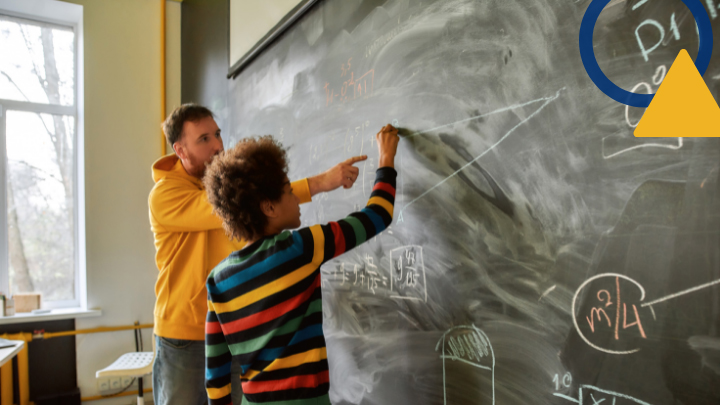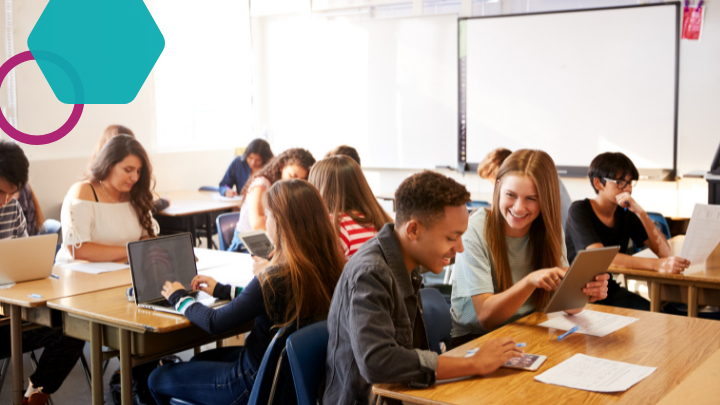This blog is the fifth in a series that highlights the work of the “Meeting the Needs of All Learners” Master Teacher Project. Each author is an experienced educator from the Kansas City area with deep expertise in differentiation and working with students with disabilities and English Learners. Learn more about the project.
Teachers know that creating modifications to tasks, differentiating instruction, and providing scaffolds to support students’ needs are not only best practices that help close achievement gaps but are also legal requirements dictated by students’ IEP, 504, and EL plans. Additionally, teachers know that there are many students who are not formally identified as needing additional services, but just need some scaffolding for certain lessons, concepts, or skills. This is especially true for students who do better with video, auditory, or visual representations, rather than just text.
While the COVID-19 pandemic has highlighted this issue, it has also provided a silver lining in that teachers have experimented with new tech tools and strategies that make lessons more visually and aurally interactive as well as fostering student voice and ownership. Furthermore, these tools and strategies can easily be transitioned back to in-person learning.
Despite the silver lining, the work of modifying, differentiating, and scaffolding can still be daunting. I have found that a few simple strategies make a big impact on a variety of lessons and help meet the needs of ALL learners.
Provide Video, Audio, and Visual Direction
What’s the strategy?
In Digital Worksheets with Video Directions, teachers will make paper and pencil assignments digital by adding in video directions. Teachers can take any template students are working on and make it digital by embedding video, audio, and visual supports for students to assist them with independent work. I’ve found this strategy to be especially helpful during activities when teachers find themselves assisting frequently with reading directions and with understanding challenging vocabulary.
Why is it useful?
This strategy provides a variety of scaffolds and modifications for students. Once students are used to the strategy and the delivery, teachers can support students in self-selecting only the scaffolds and modifications they truly need. In this way, teachers can differentiate and provide students with voice and ownership of their learning. Teachers will know the strategy is effective if students are able to complete independent work with less support.
Help Students Retell a Story or Explain a Concept Visually
What’s the strategy?
In the Visual Retelling strategy, teachers will use picture cards or props to retell a story. The Visual Retelling strategy provides students with vocabulary-building practice which will also enhance comprehension. The strategy supports all learners by providing structures and supports for language barriers, visual cues to help with comprehension, and opportunities for further differentiation by adding more pictures or props as required to meet students’ needs.
Why is it useful?
This strategy supports teachers in differentiating for students as it provides an image to students to help make content “stick” as they learn new vocabulary. Additionally, it can be used across a variety of contexts, like whole-group instruction, small group instruction, during guided reading, and even one-on-one. Just like the Digital Worksheets strategy, students can begin to self-identify when they need to consult the images for vocabulary support. This leads to more confident, metacognitive learners.
Foster Student Ownership of Their Own Support
What’s the strategy?
In the Goal Setting and Reflection strategy, students use a variety of protocols to create meaningful goals. On a regular basis, students revisit their goals and track their progress to increase ownership of learning.
Why is it useful?
I’ve found when students use a strategy like this to set goals around their use of scaffolds and supports, they become more motivated, engaged learners. This leads to increased academic performance. When I use the goal-setting strategy with my students to set goals about the scaffolds that they’re using in the Digital Worksheets strategy, they start to think critically about which scaffolds they actually need, and they become more aware of their needs. I see them using less of the scaffolds but selecting ones that are truly helpful to them and that they can use effectively.
During the COVID-19 pandemic and distance learning, I have seen my students blossom while using the Digital Worksheets and Visual Retelling strategies. When these strategies are paired with goal setting around the use of the scaffolds provided, student growth sky-rockets. I’ve witnessed students in my classes grow from using every possible scaffold in my digital worksheets to telling me they only need the drag and drop feature. This kind of growth and self-awareness about their learning is what we want for all of our students!
As educators, we can only expect to be successful when we’re truly meeting the needs of all of our students. The strategies listed above are just a few of the ways you can begin to do this. As you consider embedding more scaffolds to both differentiate and increase student voice in their learning, I’d encourage you to start small. Explore the Meeting the Needs of All Learners Master Teacher Project homepage and select one strategy to try. Once that strategy becomes a natural part of your classroom and something students are comfortable with, layer on another strategy to support the needs of all students. In this way, you will create a toolbelt of strategies that will bring new life to your classroom as students know their needs are being met.








